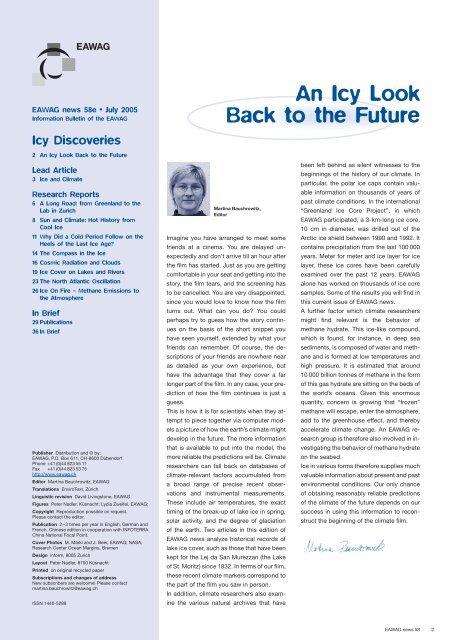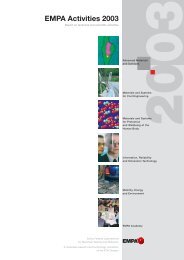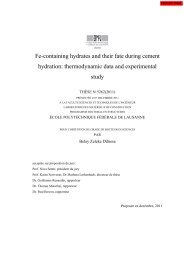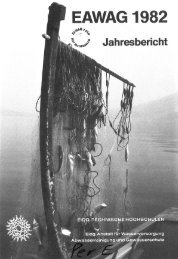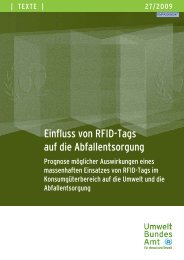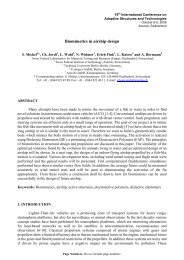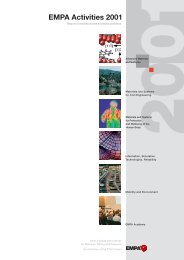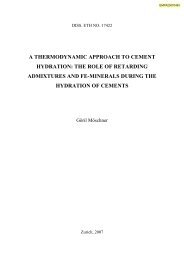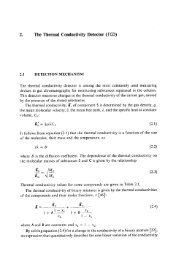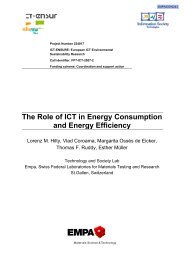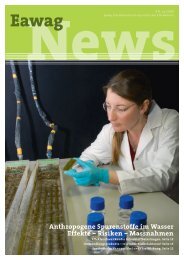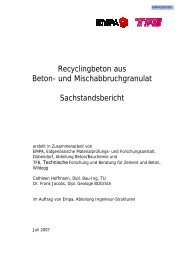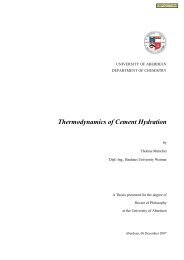Entire volume - Eawag
Entire volume - Eawag
Entire volume - Eawag
Create successful ePaper yourself
Turn your PDF publications into a flip-book with our unique Google optimized e-Paper software.
EAWAG news 58e • July 2005<br />
Information Bulletin of the EAWAG<br />
Publisher Distribution and © by:<br />
EAWAG, P.O. Box 611, CH-8600 Dübendorf<br />
Phone +41 (0)44 823 55 11<br />
Fax +41 (0)44 823 53 75<br />
http://www.eawag.ch<br />
Editor Martina Bauchrowitz, EAWAG<br />
Translations EnviroText, Zürich<br />
Linguistic revision David Livingstone, EAWAG<br />
Figures Peter Nadler, Küsnacht; Lydia Zweifel, EAWAG;<br />
Copyright Reproduction possible on request.<br />
Please contact the editor.<br />
Publication 2–3 times per year in English, German and<br />
French. Chinese edition in cooperation with INFOTERRA<br />
China National Focal Point.<br />
Cover Photos M. Märki and J. Beer, EAWAG; NASA;<br />
Research Center Ocean Margins, Bremen<br />
Design inform, 8005 Zurich<br />
Layout Peter Nadler, 8700 Küsnacht<br />
Printed on original recycled paper<br />
Subscriptions and changes of address<br />
New subscribers are welcome! Please contact<br />
martina.bauchrowitz@eawag.ch<br />
ISSN 1440-5289<br />
EAWAG<br />
Icy Discoveries<br />
2 An Icy Look Back to the Future<br />
Lead Article<br />
3 Ice and Climate<br />
Research Reports<br />
6 A Long Road: from Greenland to the<br />
Lab in Zurich<br />
8 Sun and Climate: Hot History from<br />
Cool Ice<br />
11 Why Did a Cold Period Follow on the<br />
Heels of the Last Ice Age?<br />
14 The Compass in the Ice<br />
16 Cosmic Radiation and Clouds<br />
19 Ice Cover on Lakes and Rivers<br />
23 The North Atlantic Oscillation<br />
26 Ice On Fire – Methane Emissions to<br />
the Atmosphere<br />
In Brief<br />
29 Publications<br />
36 In Brief<br />
An Icy Look<br />
Back to the Future<br />
Martina Bauchrowitz,<br />
Editor<br />
Imagine you have arranged to meet some<br />
friends at a cinema. You are delayed unexpectedly<br />
and don’t arrive till an hour after<br />
the film has started. Just as you are getting<br />
comfortable in your seat and getting into the<br />
story, the film tears, and the screening has<br />
to be cancelled. You are very disappointed,<br />
since you would love to know how the film<br />
turns out. What can you do? You could<br />
perhaps try to guess how the story continues<br />
on the basis of the short snippet you<br />
have seen yourself, extended by what your<br />
friends can remember. Of course, the descriptions<br />
of your friends are nowhere near<br />
as detailed as your own experience, but<br />
have the advantage that they cover a far<br />
longer part of the film. In any case, your prediction<br />
of how the film continues is just a<br />
guess.<br />
This is how it is for scientists when they attempt<br />
to piece together via computer models<br />
a picture of how the earth’s climate might<br />
develop in the future. The more information<br />
that is available to put into the model, the<br />
more reliable the predictions will be. Climate<br />
researchers can fall back on databases of<br />
climate-relevant factors accumulated from<br />
a broad range of precise recent observations<br />
and instrumental measurements.<br />
These include air temperatures, the exact<br />
timing of the break-up of lake ice in spring,<br />
solar activity, and the degree of glaciation<br />
of the earth. Two articles in this edition of<br />
EAWAG news analyze historical records of<br />
lake ice cover, such as those that have been<br />
kept for the Lej da San Murezzan (the Lake<br />
of St. Moritz) since 1832. In terms of our film,<br />
these recent climate markers correspond to<br />
the part of the film you saw in person.<br />
In addition, climate researchers also examine<br />
the various natural archives that have<br />
been left behind as silent witnesses to the<br />
beginnings of the history of our climate. In<br />
particular, the polar ice caps contain valuable<br />
information on thousands of years of<br />
past climate conditions. In the international<br />
“Greenland Ice Core Project”, in which<br />
EAWAG participated, a 3-km-long ice core,<br />
10 cm in diameter, was drilled out of the<br />
Arctic ice shield between 1990 and 1992. It<br />
contains precipitation from the last 100 000<br />
years. Meter for meter and ice layer for ice<br />
layer, these ice cores have been carefully<br />
examined over the past 12 years. EAWAG<br />
alone has worked on thousands of ice core<br />
samples. Some of the results you will find in<br />
this current issue of EAWAG news.<br />
A further factor which climate researchers<br />
might find relevant is the behavior of<br />
methane hydrate. This ice-like compound,<br />
which is found, for instance, in deep sea<br />
sediments, is composed of water and methane<br />
and is formed at low temperatures and<br />
high pressure. It is estimated that around<br />
10 000 billion tonnes of methane in the form<br />
of this gas hydrate are sitting on the beds of<br />
the world’s oceans. Given this enormous<br />
quantity, concern is growing that “frozen”<br />
methane will escape, enter the atmosphere,<br />
add to the greenhouse effect, and thereby<br />
accelerate climate change. An EAWAG research<br />
group is therefore also involved in investigating<br />
the behavior of methane hydrate<br />
on the seabed.<br />
Ice in various forms therefore supplies much<br />
valuable information about present and past<br />
environmental conditions. Our only chance<br />
of obtaining reasonably reliable predictions<br />
of the climate of the future depends on our<br />
success in using this information to reconstruct<br />
the beginning of the climate film.<br />
EAWAG news 58 2


